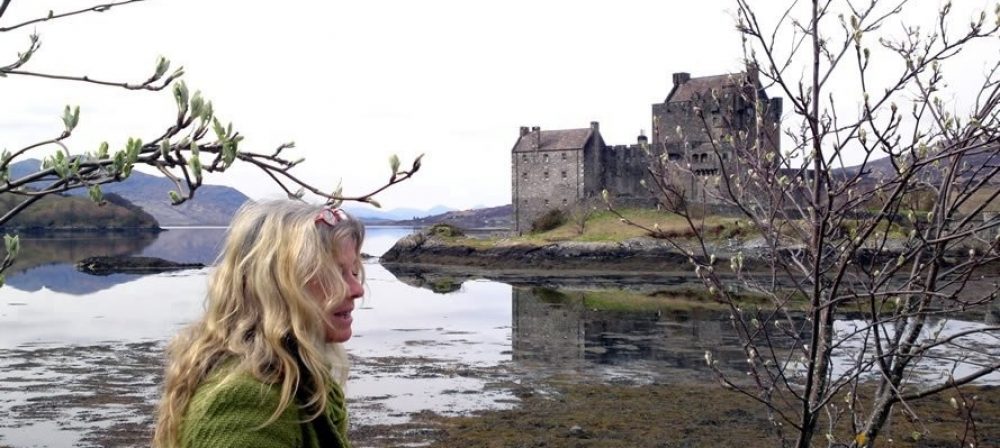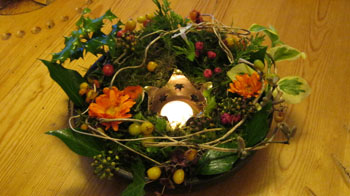midwinter solstice
First you need to shed all you know
or can name
then you need to step out of
your shoes, your shadow, your own
light, and your home. Strip
naked as the four winds
and forget being upright
unless you want to dance, and then
dance the stone row to the stone circle
and allow the sky to take your voice.
This is the season of yew and periwinkle
of Persephone’s descent
to the winter god.
Watch for the barn owl
and Hecate at the crossroads
and prepare to hang from the World Tree
until you are sobered by silence
and stillness, and the great
white unending song of the spheres.
Kneel on the earth until
you become a reed, a snail, a fox,
another word for truth.
Be the berry in the dark stream
that the water bears away.
Transformed into all
you may be, step forward and cross
the threshold, gateway to gods
and ancestors, to what will endure
beyond all that you can imagine
of the play of particle, of wave –
take the hand that’s offered, step through
this gateway to the light that burns within
which now you’ll never lose again.
© Roselle Angwin
At the midwinter solstice, the sun rises and sets at the most southerly extent of its trajectory. In the Arctic, it doesn’t rise above the horizon at all. In the Antarctic, it doesn’t set. Here in the northern hemisphere the sun does a mini-arc from southeast to southwest, and the winter solstice marks the shortest day of the year. In a couple of days’ time – see the next sentence – we will slowly and imperceptibly but surely be turning back towards the light.
We are at a time in the year’s turning when for three days the sun will appear to stand still in the heavens – the word ‘solstice’ means that.
In many cultures the solar god figure was interred, hung from the tree (think Odin/Woden, and also the Hanged Man of the Tarot), or dismembered like Osiris, for three days and nights at this midwinter time, to be born again, as the sun seems to be after this time of the shortest day, towards a gradual lengthening of daylight, once the sun moves on.
It’s no coincidence that Jesus’ birthday has been determined as occurring close to the winter solstice (though you will remember that we mark his three-day interment at Easter, the old Oestre, in March). Jesus (the Lamb of God) is the reborn solar god of the great 2000 years of the Earth Age of Pisces.
Of the preceding Age of Aries the Ram (father of the Lamb?), we had the sun-god Mars/Ares/Apollo, and Moses or Amon-Re, most likely also to be born on the winter solstice. The Age of Taurus, the Bull, preceding that again, was symbolised by Mithras, also born as a sun-god on the winter solstice.
And Taliesin, the great Celtic bard, prophet and magician, was supposedly born on the winter solstice.
This time is very much connected with King Arthur and his rebirth, as the solstice’s name of Alban Arthan tells us. (Also in the picture are Arthur as Bear, the Pole Star and the yew tree.)
In some tales, and Gawain and the Green Knight is one, the ‘solar deity’ is challenged for his life by he who doesn’t die, the Evergreen One of the Wildwood, at the solstice.
In West Cornwall, there are some enigmatic underground chambers called ‘fogous’. Many stretch for quite some metres, and many have little round side-chambers known as ‘creep’ chambers. They’re Iron Age in origin, and we don’t know what they were built for.
Some suggest that they had ritual significance, and this seems likely. Other barrows have similar side-chambers (for instance in Brittany), and the thinking is that an initiate would be entombed, alive, in this little womb-like chamber for three days and three nights, to be ‘reborn’ at the midwinter sunrise (usually; sometimes solstice sunset) when the entrance was unblocked and light would pierce the chamber. This sensory deprivation would have either killed through shock, made mad ditto, or transformed the individual.
Until the house was sold some years ago now I used to lead residential workshops at a place called Rosemerryn, near Lamorna Cove in West Cornwall. The house was built within a double concentric earthwork dating from the Iron Age, and it has a magnificent fogou in the grounds close by. Just up the road is the Merry Maidens, or Dawns Men (‘stone dance’) stone circle dating probably from the early Bronze Age, opposite a pair of tall menhirs known as the Boleigh Pipers. Close by is another menhir, the Fiddler. (West Cornwall has a very dense concentration of prehistoric monuments.)
Although I was never there at the solstice, sometimes we entered the dark throat of the fogou, and lit candles to float in the deep puddle caused by the collapse of part of the roof – a magical experience, and in itself gently transformative.
Here are two poems written after entering the Boleigh Fogou a few years ago. They both appear (the second in a slightly different format, a prose poem like the first, below) in my collection Bardo – an appropriate title for this liminal time.
~
Boleigh Fogou at midwinter 1
I am the dream of leaves in the bulb. I am the silence of under. Am winter.
Stone I have known; the tender touch of brow under me; rain –
I am waiting for rain; rain and the eyebeams of the new young sun.
I have softened into earth. I am in the blue dark, crouching. I pray.
~
Boleigh Fogou at midwinter 11
Light that turns, hesitates, reverses.
Time’s thumbprint marking my edge.
The dark pool of bitter midwinter –
we’re standing in underground water.
I am a bowl of silence. Rooks knock
at my chest, beaking the leaf-winged air.
Initiations of the present moment. In the cove
below light slides and breaks, and breaks.
To give up one’s life to depth.
Nothing matters more than this everything.
© Roselle Angwin 2009/2011
You can see more solstice poems if you look for solstice posts somewhere around 20/21 December on my blog.
My own personal celebration of this time this year, 2016, began on the evening of Tuesday 20th with candles, a fire, and a small celebratory draft of chestnut liqueur (in the absence of apple brandy, the apple tree being one of the trees of this time, along with the evergreens such as yew, holly and bay, and plants like ivy, rosemary and mistletoe).
This morning, I went out into the dark garden before sunrise; a waning moon, Jupiter and Venus visible; an owl and a thrush (singing its spring song already) in the valley, and the usual raucous chorus of rooks and jackdaws. In the southeast was a narrow band of bright pink, and I asked the sun to rise also in my chest, and help me send blessings to all whom I love and to all who are suffering at this time. I then went and spoke to all the fruit trees in our field, thanking them for this year’s harvest.
Back indoors, I lit the solstice candle and offered a solstice meditation and invocation to the gods, remembering also the close family members who have left this life at this time in a previous year. I walked the lanes to collect the contents for my solstice garden (as in the image above); few berries now after the frosts and rain (and also the migrating flocks of redwings and thrushes), but periwinkles and primroses are out.
Then I prepared for storage the bay leaves I collected, this year as last year, from a friend’s tree in the Cévennes mountains, now dried, and added the stems to the fire for this evening. I also rubbed the leaves of lemon verbena from my little shrub, dried, into a jar for the winter, and made an infusion to drink.
Then my elderly deerhound, Companion of the Ways, and I had a stroll to the winter brook.
I wish you joy and abundance as we turn back towards the sun.

